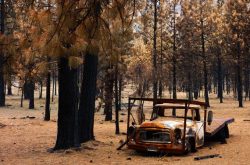
The 2014 Carlton Complex wildfire in north central Washington was the largest contiguous fire in state history. In just a single day, flames spread over 160,000 acres of forest and rangeland and ultimately burned more than 250,000 acres in the midst of a particularly hot, dry summer.
The wildfire, driven by strong winds and explosive growth, was unprecedented in how it burned the landscape, destroying more than 300 homes in Washington’s Methow Valley. But “megafires” like the Carlton Complex are becoming more common in western U.S. forests as the climate warms and forests are crowded with trees after years of fire exclusion.
In the first major study following the devastating Carlton Complex fire, researchers from the University of Washington and U.S. Forest Service found that previous tree thinning and prescribed burns helped forests survive the fire. The study, published Feb. 22 in the journal Ecological Applications, shows that even in extreme wildfires, reducing built-up fuels such as small trees and shrubs pays off.
“Our study suggests that the fuel treatments were worth the investment, yielding a more desirable post-fire outcome than if they hadn’t been implemented,” said lead author Susan Prichard, a research scientist at the UW School of Environmental and Forest Sciences. “There are a lot of benefits to creating more resilient landscapes, and this study suggests that even in the worst-case scenario wildfires, it can be worth it.”
While this study focused on the Carlton Complex fire, its results have broader implications for forests around the world that are prone to wildfires. This work adds to the growing library of studies showing how thinning trees and controlled burns can reduce the severity of the next fire on the landscape.
Read more at UW News »
